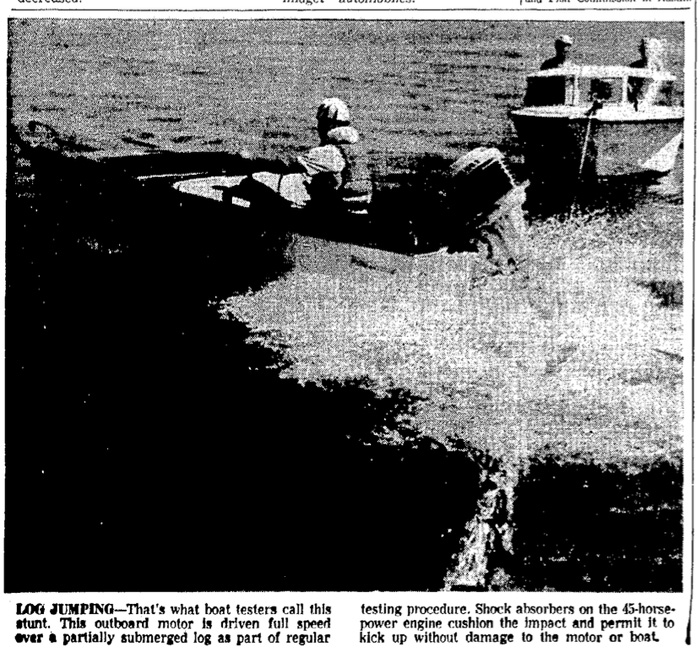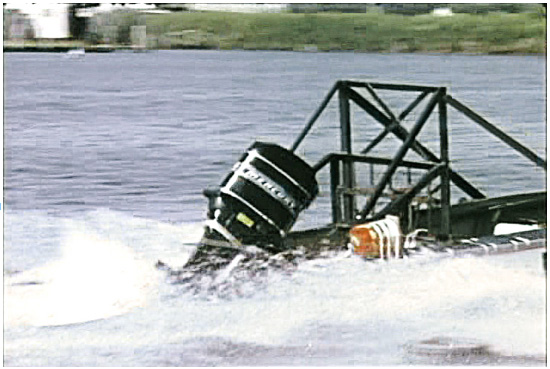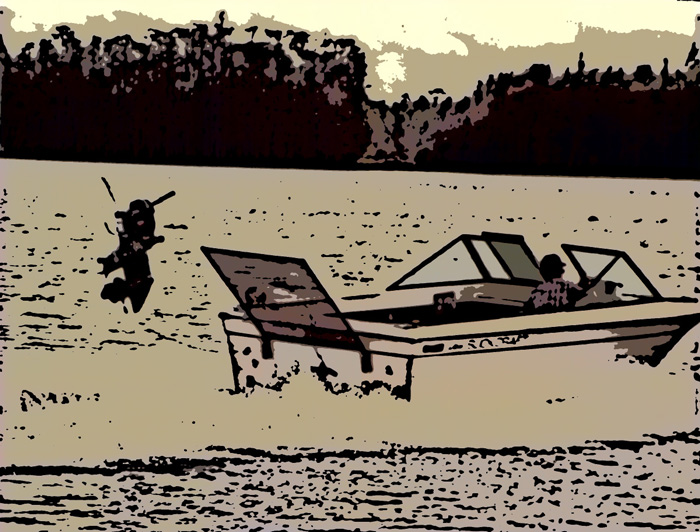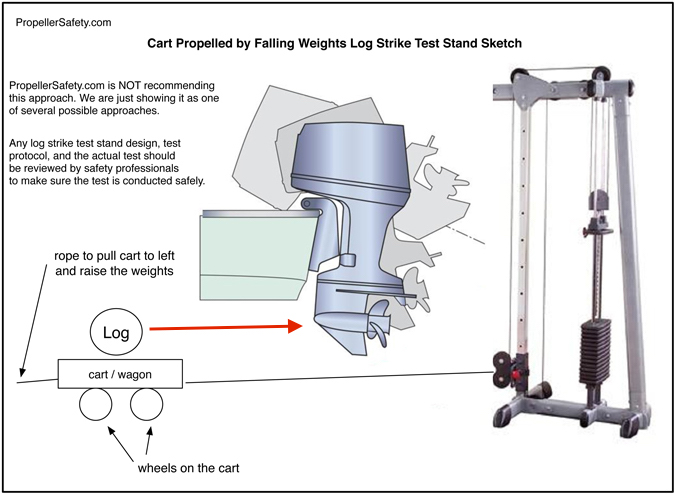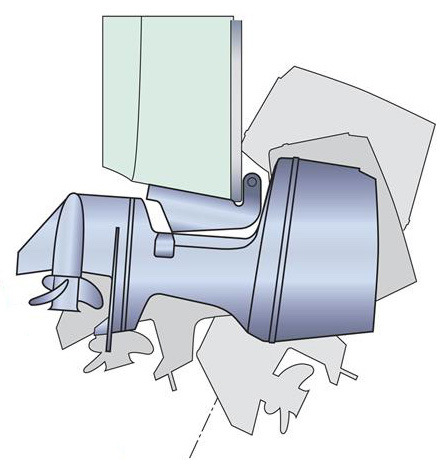Designing a Log Strike Test Stand to Verify Durability of Outboard Motor Prototypes
We have previously written extensively on log strike testing, the variables involved, and more specifically on trying to prevent outboard motors from breaking off and entering boats after striking floating or submerged objects.
This installment focuses purely on durability testing of prototype outboards. It does NOT address the issue of outboard motors breaking off and flipping into boats, the need to make sure production outboards maintain the same durability, production quality control issues, design changes, or other issues. It purely focuses on developing a test stand and a test protocol to test a single prototype outboard motor for durability in striking floating or submerged objects.
Note – the Asian outboard manufacturers tend to refer to log strike testing by the phrase, driftwood testing.
Note – Log strike testing is DANGEROUS, please read the DISCLAIMER at the bottom of this post.
This post is not meant as a “pick one” offering. It is more of buffet from which manufacturers new to log strike testing consider picking some things if they like them and bring some of their own ideas to the table as well to create something that works for them at the stage they are now in.
On Water Log Strike Testing
Most major outboard manufacturers now have a log strike test procedure in place for durability testing of outboard motors. Some still perform on water testing by running flat bottomed boats over floating logs.
What the image above lacks in clarity it shows in intent. An outboard manufacturer is trying to prove to themselves and others, their outboard motor is durable, and specifically durable enough to survive a log strike.
About as soon as they started on water log strike testing in the late 1950’s, manufacturers quickly began to build cages or fences on test boats to prevent the outboard motor or parts of the outboard motor from flipping into the vessel and injuring the operator. On water log strike test boat operators also typically wear helmets.
An example of a log strike test fence Mercury used with stern drives is shown below.
Mercury drove their through hull Zeus drive over a fixed underwatewall to test its breakaway system.
See the video below at about 3 minutes and 50 seconds into the video
On water log strike testing has its issues:
- Repeatability
- Variability between logs
- Have to temporarily anchor the logs
- Hard to water soak the logs to all be the same and float at same depth
- Hard to test in bad weather
- Hard to hit every log squarely and at exactly the same spot on the drive and at exactly the same speed
- Expensive one of a kind prototype outboards may break off and be lost in the lake
- Hard to recover parts that break off
- Instrumentation challenges are much more difficult in a boat moving on water than in a land based test
- High speed video is much easier to shoot on land than on the water
- It is easier to protect those conducting the test during on land testing that during on water testing. Safety of the boat operator is a concern during on water log strike testing.
But nonetheless, on water testing is seen as the gold standard. The ability to strike a log at speed and still be able to at least limp back to where you came from is the goal of the on land / dryland tests. What better way to prove that than on the water.
However, due to the issues listed above, some manufacturers have pushed log strike testing to land based test stands.
On Land Log Strike Test Stands
Mercury Marine’s Dryland Log Strike Test Stand
Mercury Marine is the only outboard manufacturer to publicly release photos of their “on land” / “dryland” test fixture or videos of actual on land / dryland log strike tests.
Mercury provided a high speed slow motion video of their test in the 2014 video below at about 55 to 59 seconds into the video.
Note: To advance a YouTube video one frame at a time, play the video till it gets to the section of interest, stop the video, then advance it a frame at a time using the period key on the keyboard. You can similarly reverse it a frame at a time using the comma key.
Note – Mercury uses a transom with the outboard mounted to it, then propels a “simulated log” down a set of rails at the outboard motor. In Mercury’s testing the outboard is stationary while the log is moving vs on water testing where the boat and outboard are moving while the log is stationery.
Several years ago Mercury commissioned a study to mathematically show the loads are the same in both instances (boat moving vs log moving).
Mercury released another video of their testing in 2010.
Mercury 2010 log strike test video
Although we do not recall Mercury every saying it, one thinks they would have observed damages / broken components / failures caused to certain drives in on water log strike testing, then designed the test fixture to replicate those damages / broken components / failures at the same speed (or at a speed that could be related to the on water test speed). Thus the test stand would replicate on water testing. We are not saying their stand does not replicate on water durability failures, we are just noting Mercury has not publicly released documents showing similar failures at similar speeds (on water vs. on land).
Cummins Mercury Zeus drive log strike testing
Cummins and Mercury / MerCruiser were especially concerned about the Zeus through hull drive. If the drive were to impact a large log, submerged wall, or ground and rip off part of the bottom of the hull, the boat could sink. They tested the breakaway drive on water as seen above, and by propelling a weighted cart at it as seen in the video below at about 3 minutes and 30 seconds into the video.
Cart Propelled by Falling Weights Log Strike Test
At least one outboard manufacturer has dropped a weight to propel a cart at the marine drive. The technique resembles a selectorized weight lifting machine as seen in the image below.
Comments on the Cart Propelled by Falling Weights Log Strike Test Stand above:
- The outboard motor tilting and trailering image in the sketch above was derived from a Yamaha marketing image
- The cart in the image above is designed to ride in a track or to follow one or more rails.
- When the weight stack is dropped, the cart is propelled toward the outboard motor. A crash barrier will need to be placed between the outboard motor and the lower pulleys to capture the residual energy of the cart. A close look at the Cummins Mercury video shown twice above on this page shows them using an old vehicle as a crash barrier.
- Weights can be added to the cart.
- Real life scale would be much larger than shown in this image. Likely a very heavy weight dropped a distance of many feet.
- The log needs to be securely affixed to the cart so the impact includes the energy of the cart.
- The transom and outboard may need to be allowed to move vertically and horizontally toward the weight stack (like Mercury’s dryland log strike test transom moves in the videos above)
Although it is not obvious in the Zeus video previously referenced, Mercury may have used a dropped weight to propel the cart at the Zeus drive.
Vertically Dropped Weight Log Strike Test
Imagine rotating the transom and outboard motor as seen in the Dropping Weight With Cart test image above 90 degrees clockwise as seen in the image below.
Now imagine dropping a heavy weight from a height many feet above the outboard motor in a manner so the weight barely clears the bottom of the boat in the image above, but does strike the lower leg of the outboard motor.
The weight dropped could have a resilient surface, such as a rubber tire tread or lead on the side that impacts the outboard to simulate the crushability of a log.
Back in the 1970s I witnessed some of the early tractor ROPS (Roll Over Protection Structure) and FOPS (Falling Object Protection Structure) testing in which heavy weights were dropped from considerable heights to impact ROPS/FOPS.
A modern version of that testing is seen in the YouTube video below:
A more professional looking version of a similar FOPS test is shown below.
Imagine dropping a heavy weight like in the ROPS/FOPS test but dropping it at the outboard motor mounted horizontally in the image above the ROPS/FOPS video.
Pendulum Testing
Pendulum testing outboard motors can be conducted two ways.
1. The outboard (typically without the powerhead) is rotated up till its leg is in a horizontal position, the outboard is released and swings downward. As the lower leg of the outboard becomes approximately vertical it strikes something placed there to represent a severe impact.
2. The outboard remains in a near vertical position, a heavy object (think of a wrecking ball) is pulled back and upward, then released. The heavy object swings down and impacts the lower leading edge of the outboard motor.
Colorado State published a YouTube video of them pendulum testing a carbon fiber nose cone for a race car.
Colorado State raised the weights with a fork truck. A similar test might be able to be conducted with an overhead hoist with an electronic link that could be released on command.
Its pretty easy to envision an approach of this nature as a log strike test for an outboard motor.
It is our understanding Outboard Marine Corporation (OMC) was in process of moving their log strike testing to dry land when their company declared bankruptcy in December 2000. I seem to recall they were going to use a pendulum test fixture. They were likely going to swing a weight with something soft (like lead) on the impact surface at the lower leg of the drive.
The Society of Automotive Engineers (SAE) has some standards governing pendulum testing of automobiles and their components.
The International Journal of Impact Engineering published an article on pendulum testing of roadside rail barriers that provides some insights into how this method could be adapted to outboard motors.
Pendulum testing as a means of assessing the crash performance of longitudinal barrier with minor damage
International Journal of Impact Engineering
Volume 37 (2010). Pages 1121-1137.
Mercury used a pendulum test in developing and verifying their computer log strike simulations. In those tests, Mercury allowed the drive to rotate down and impact a bendable metal strap.
Mounted on Ground Vehicle Testing
One could mount the outboard on the back of a ground vehicle such as a jeep or an ATV and drive it manned or unmanned over an obstacle sticking up out of the ground, such as the manhole cover test shown by Deer in the video below. If one attempts a manned or unmanned test of this nature, attention to personal safety would be paramount.
Using this method with an outboard, you would basically be driving the “jeep” over a solid wall protruding up from the ground a distance less than minimum ground clearance of the jeep with a width less than the inside distance between the jeep’s tires.
If you used a passenger vehicle, it might fire the airbags during impact.
A test could be setup where something like an old junker unmanned jeep ran down a hill in a straight line with the outboard mounted on a transom securely mounted to the rear of the jeep. This test would be hard to exactly duplicate in the future. But is could show the outboard could take a considerable strike. Additional weight could be loaded into the jeep.
Test Protocol
Existing outboard manufacturers that conduct log strike tests on water or on land tend to have a log strike test protocol. The test protocol is an official engineering document that details exactly how the test is to be conducted and what constitutes passing or failing the test.
They usually want the outboard to be able to still be capable of running, have steering, and be able to be driven back to shore even if it has to limp some (may not capable of full speed, not capable of full trim, etc.) Leaking fluids into to the water (oil) may also be cause for failing the test.
Outboard manufacturers usually to not want any parts of the outboard to enter the boat during the test.
Some manufacturers test at a series of speeds, like hit it lightly, moderately, then heavily a few times.
A test protocol should also include safety precautions to be taken during testing.
The outboard log strike system (pump, trim, and tilt cylinders, etc) would need to be mounted and have all the air flushed out of it so the system would duplicate its actions on a boat.
Variables to be recorded, photographs to be taken, and video / high speed video recording of the impact would need to be spelled out in the protocol. Some things might be on a checklist to allow selecting certain options for some impact tests.
Everything needs to be spelled out in detail in the test protocol, including trim position / trim angle at time of strike, transom angle, etc. Otherwise those present may be conduct the test differently every time it is ran and have their own ideas about if the outboard passed or failed the test.
On Water, Indoors, Outdoors, or Under a Shelter?
Earlier we suggested “on land” testing is likely safer that “on water” testing.
If you decide to test on land, you have the choice of testing indoors, testing outdoors, or testing outdoors under a shelter.
In terms of any electronics, instrumentation, and video it will be easiest to test indoors.
However, as seen in the videos above, testing indoors looks the most dangerous. Things are close together, people are closer, even the building itself could be damaged..
Testing outdoors in countryside eliminates many hazards but makes the electronics, instrumentation, and video work more challenging, plus it exposes you to the weather and likely gives you a dirt floor unless you are testing on a cement apron. The floor (ground) may not be level.
One possible compromise is to test outdoors at least partially under some sort of cover, such as a tent. You could leave the sides open or let them down to adjust lighting, block the wind, keep out some of the cold, etc. Get a large enough tent (you can rent them) it will not create some of the problems created by being indoors.
We are not saying any of these approaches is the best, we are just presenting them so you can consider the range of options and some of the advantages and disadvantages of the various approaches.
Be sure your safety people are involved in selecting the best and safest venue for your log strike testing.
Tips for Log Strike testers
Tips:
1. You may find Stresscoat helpful. As described per their website, “Stresscoat coatings provide a graphic picture of the distribution, direction, location, sequence and magnitude of tensile strains.” Stresscoat can really give you some insight into what is going on. Some manufacturers in other industries use stresscoat to determine where best to put strain gauges for more indepth analysis.
How Do We Size These Log Strike Test Stands to Provide the Appropriate Loads
We are currently working on a companion post that addresses this topic.
Software Tools for Simulating Log Strike Tests
Some manufacturers now use Finite Element Analysis (FEA) and other software tools to help insure new designs and major changes to existing designs will pass the log strike test before prototypes are built.
In 2008 Mercury presented a paper on how they try to make sure their drives will pass the log strike test before the test is actually ran by developing Finite Element Analysis (FEA) models and other software tools to the point at which they have confidence their results will closely match real world log strike test results.
Crash Prediction for Marine Engine Systems Presented at the 2008 Abaqus User’s Conference
Arden A. Anderson
Mercury Marine
DISCLAIMER
Log strike testing is dangerous.
This post is NOT professional advice.
This post is NOT a recommendation to use any of the methods discussed on this page.
It is a review of practices, many of which are or have been used by the industry.
Any use of any of these methods is at your own risk.
We are not guaranteeing any methods shown on this page actually replicate survivability of on water log strikes.
Safety professionals should be involved in all log strike test fixture designs and test procedures / test protocols. Your safety team could probably begin to identify some of the hazards associated with log strike testing by watching the videos of this page.
Suggestions Are Welcome
If anyone is aware of another reasonably practical way to simulate log strike impacts, please submit them using the comment system below, or contact us directly using the “Contact Us” link in the menus at the top of the screen.
